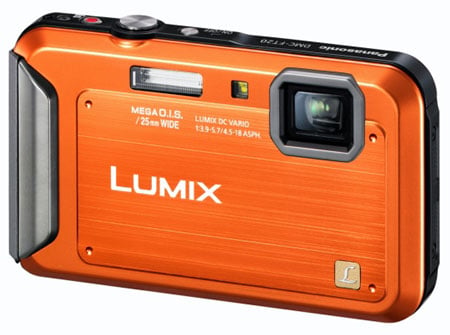Panasonic Lumix TS20 / FT20 review
-
-
Written by Ken McMahon
Verdict
The Panasonic Lumix TS20 / FT20 is a competitively priced point-and-shoot compact that is water-proof, dust-proof and shock-proof. It can be used underwater to a depth of 5 metres, dropped from a height of 1.5 metres and frozen to -10 degrees C. Its more conventional specifications include a 4x stabilised optical zoom lens, 16.1 Megapixel CCD sensor and a 2.7inch LCD screen.
The Lumix TS20 / FT20 is a lightweight slim compact, which has the same advantages in the water as out – it’s easy to stash away when you’re not using it and can be held in one hand when you are. But the smallness of its controls and their patent unsuitability for the environments for which the camera is intended count heavily against it.
Among its strengths are a super-wide 25mm focal length, versatile AF options, and a reduced resolution 3.1 Megapixel burst mode that operates at 8fps. It also has a wide range of scene modes, including Miniature, which can be used for movie as well as stills shooting. Lastly, it’s priced at a point that not only makes it very attractive compared with other water-proof compacts, but makes it a viable option for those on a budget who want a ‘normal’ point-and-shoot compact that they can occassionally take into the water. Now before wrapping-up, let’s briefly look again at how it compares to the pricier Canon PowerShot D20.
 |
Compared to Canon PowerShot D20
The Most obvious differences betwen the Canon PowerShot D20 and Panasonic Lumix TS20 / FT20 are physical ones. The Lumix TS20 / FT20 is much more compact and almost half the weight of the PowerShot D20. Size and weight can be an important factor when you’re outdoors and carrying other kit, but it cuts both ways – the D20’s larger size and functional design makes for easier handling. It would be fair to say that the D20 looks and handles like it was designed for purpose, whereas the TS20 / FT20 looks like an ordinary compact that’s been sealed. Talking of which, if you plan on submerging more than a few metres, the D20 can safely dive to a depth of 10 meters compared with only 5 meters for the TS20 / FT20
So much for handling, what about the specifications? The D20’s 5x zoom outreaches the 4x zoom on the TS20 / FT20, but it lacks the latter’s super-wide angle view which could be an important factor for landscape shooters, boaters, cavers, pot-holers and campers. The PowerShot D20’s 3 inch screen provides a better view for framing up shots than the 2.7inch screen on the Lumix TS20 / FT20.
While neither has great continuous shooting performance at full resolution, the Lumix TS20 / FT20 does at least allow you to shoot an 8fps high speed burst at reduced 3.1 Megapixel resolution. The D20 has the advantage of being able to shoot full 1080p HD video compared with 720p on the TS20 / FT20, and both allow you to shoot with effects like Miniature, but the D20 is a more versatile movie camera with more modes.
Finally, the PowerShot D20 has a built-in GPS receiver which not only tags your photos with location data, allowing you to map them using software or on photo sharing websites, it also has a track log function so you can plot the course of a trip. Personally, I think this is a really useful feature, whether you just want to keep track of holiday snaps, or plot the route of outdoor expeditions.
Of course, features like GPS all add to the price. The PowerShot D20 costs around twice as much as the Lumix TS20 / FT20. For some, the design, extra zoom range, greater depth, better video capabilities and GPS will be worth the extra. But if you’re looking for an all-round point-and-shoot compact for occassional use in the pool and at the beach, the Lumix TS20 / FT20 is a better choice.
See my Canon D20 review for more details.
Panasonic Lumix TS20 / FT20 final verdict
The Panasonic Lumix TS20 / FT20 probably won’t find much appeal either with photography enthusiasts or those who take their outdoor and water-based pursuits seriously. It’s a point-and-shoot compact, which photo enthusiasts tend not to get enthusiastic about, but it’s also a pretty conventional compact to which water, dust and shock-proofing have been added. If you’re looking for a camera primarily to use in the water there are other, better, though generally much more expensive options, ranging from the Canon PowerShot D20 to the GoPro Hero3.
For anyone seeking a general purpose compact they can occasionally use in the water though, the Lumix TS20 / FT20 is an excellent choice. It may have a pretty basic specification and if you’re looking for top quality stills and video, a nice big LCD screen, or a profusion of video modes you’ll need to increase your budget and look elsewhere. But if you’re after a basic point-and-shoot that you can take on holiday to get right in to the action in the pool and on the beach then you won’t be disappointed.
Bad points | Scores (relative to 2012 waterproof compacts) |
 | ||
Build quality: Image quality: Handling: Specification: Value:
Overall: |
17 / 20 16 / 20 16 / 20 15 / 20 17 / 20
81% | |||





